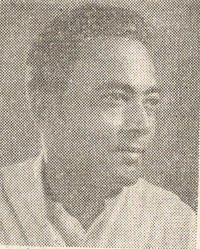S. K. Dey
S. K. Dey | |
|---|---|
 Dey in 1962 | |
| Member of Parliament, Lok Sabha | |
| In office May 1962 – May 1967 | |
| Preceded by | N K Somani |
| Constituency | Nagaur |
| Member of Parliament, Rajya Sabha | |
| In office 31 January 1957 – 1 March 1962 | |
| Preceded by | Surinder Kumar Dey |
| Personal details | |
| Born | Surinder Kumar Dey 13 September 1906 Sylhet District, Bengal Presidency |
| Died | 24 May 1989 (aged 82) New Delhi, India |
| Profession | Politician, social engineer, author |
Surendra Kumar Dey (13 September 1906 – 24 May 1989)[1] was an Indian politician, social worker, and author who served as the first Union Cabinet Minister for Cooperation and Panchayati Raj.
He contributed to the implementation of the Panchayati Raj system, a governance model emphasizing decentralized administration at the village level.[2]
Early life
Dey was born on 13 September 1906 in the Sylhet district in the Bengal Presidency, present-day Bangladesh. He studied engineering at Purdue University and the University of Michigan in the United States.[3]
Career
Dey began his career as the Honorary Technical Advisor to the Ministry of Rehabilitation for the Government of India from 1948 to 1951. He worked on rehabilitation efforts for displaced persons following the Partition of India. during his time as Technical Advisor
Ministerial tenure
Dey was appointed Minister for Cooperation and Panchayati Raj under Prime Minister Jawaharlal Nehru. He implemented the Community Development Programme (1953), which laid the foundation for Community Development Blocks across the country.[4]
He was a member of the Balwant Rai Mehta Committee (1957), the committee which recommended the formation of a three-tier Panchayati Raj system in India.
Rural township
In 1949, Dey proposed the idea of an agro-industrial township for rural development. The model focused on combining agriculture and industrial development, with the township receiving support in the form of goods and services from surrounding villages. It was designed as a self-sufficient and cooperative model.
This model materialized as the Mazdoori Manzil project in 1950, in Nilokheri, Haryana. The project provided rehabilitation for 7,000 refugees from Pakistan.
The Nilokheri model received praise from Prime Minister Nehru, who reportedly encouraged the replication of such townships countrywide.
Dey was influenced by Rabindranath Tagore's Sriniketan experiment in rural development and the Gandhian idea of Rural Construction, which stressed self-sufficiency and manual labour. Dey's approach to rural development was influenced by Rabindranath Tagore's Sriniketan project and Mahatma Gandhi's principles of rural reconstruction. His ideas combined aspects of Liberalism, Marxism, and Gandhism: individual liberty, the right and duty to work, and support for small-scale cottage and village industries.
Panchayati Raj
Dey was a member of the Balwant Rai Mehta Committee (1957), which was formed to study the Community Development Programme. The committee assessed the programme's success in utilizing local initiatives and creating institutions to sustain improvements in rural economic and social conditions. It concluded that community development would be truly effective only if the community was actively involved in planning, decision-making, and implementation, thus advocating for a strong Panchayati Raj system. The Balwant Rai Mehta Committee proposed a developmental role for Panchayati Raj institutions in rural development, considering them essential for the success of community development and national extension programmes.
Dey attributed philosophical connotations to Panchayati Raj, which he explained in his book Panchayat-i-Raj, a Synthesis.[5] He described Panchayati Raj as an important link between the individual and the world, visualizing an intimate relationship between the Gram Sabha and the Lok Sabha, and stating that democracy should flow from Parliament to the Gram Sabha. Dey urged state governments to prioritize establishing PRIs in their respective states.
This advocacy contributed to the growing political consensus and administrative momentum required to institutionalize decentralized governance structures.[6][7] The recommendations of the Balwant Rai Mehta Committee,[5][8] catalyzed a shift in policymaking. As a result, state governments initiated legislative processes to implement Panchayati Raj Institutions (PRIs) more systematically.
By the 1960s, all states had enacted legislation for PRIs, leading to the establishment of over 217,300 Panchayats.
Other achievements
Dey was involved in establishing the National Development Council and contributed to development journalism by guiding "Kurukshetra", a publication of the Ministry of Rural Development.[9][10][11]
References
- ^ "Lok Sabha Debates (Fourteenth Session, Eighth Lok Sabha)" (PDF). Lok Sabha Debates. 51 (1): 3–4. 18 July 1989. Retrieved 15 June 2022.
- ^ "Keep your passion, and career entwined". 13 February 2025. Archived from the original on 13 February 2025.
- ^ ""Lok Sabha Debates (Fourteenth Session, Eighth Lok Sabha)." p 3-4" (PDF). eparlib.nic.in. 18 July 1989. Archived (PDF) from the original on 12 August 2024. Retrieved 22 February 2025.
- ^ Dey, S. K. (1962). Community Development: A Chronicle, 1954-1961. Ministry of Information and Broadcasting, Government of India.
- ^ a b https://www.worldcat.org/title/10211322
- ^ https://rural.nic.in/en/about-us/history/panchayati-raj
- ^ https://www.epw.in/journal/1992/26/review-rural-affairs-review-issues-specials/understanding-panchayati-raj.html
- ^ https://niti.gov.in/planningcommission.gov.in/docs/reports/sereport/ser/stdy_edu.pdf
- ^ "Archived copy" (PDF). Archived from the original (PDF) on 14 August 2014. Retrieved 14 August 2014.
{{cite web}}: CS1 maint: archived copy as title (link) - ^ Kumar, Kapil (January 2007). "A Journal on Rural Development" (PDF). Kurukshetra. 3: 52.
- ^ "List of Former Members of Rajya Sabha (Term Wise)". 164.100.47.5. Archived from the original on 21 March 2019. Retrieved 29 March 2025.